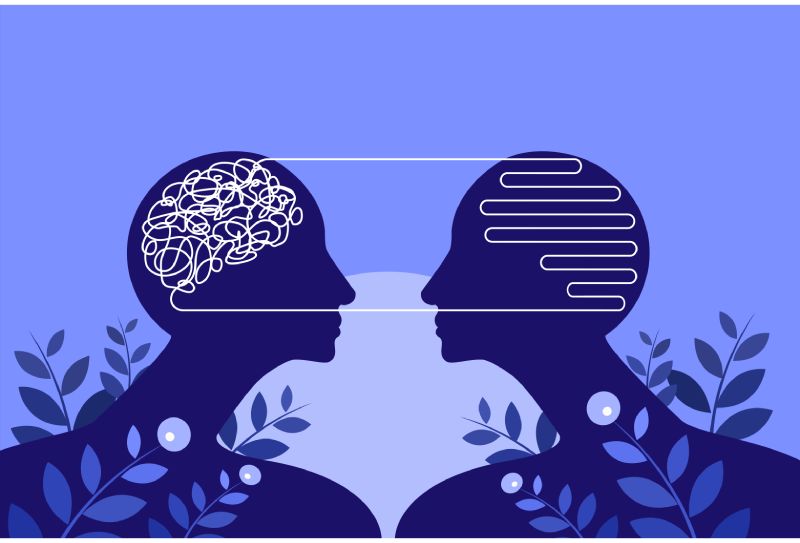NLP or hypnotherapy—what’s the difference? What do they do?
Most importantly, which is right for you?
Often, people mistakenly believe NLP and hypnotherapy are the same—but there’s actually a big difference between the two.
Today, I want to walk you through those differences and what they mean for your own personal transformation—and perhaps even your career.
Let’s get started!
What is NLP?
Neuro-Linguistic Programming, also known as NLP, is a therapy that helps us change the way we think and feel so we can achieve our goals.
This includes changing the way you talk and observing your behavior patterns.
For example, if you went to a therapist for NLP and said, “I always fail. I’m such a disappointment.” They would likely ask, “Always? Do you really always fail? Let’s look at that belief.”
NLP uncovers and reprograms such limiting beliefs to bring about a behavior change.
It works by identifying the thought patterns and behavior of successful people, and applying them to the client’s circumstances.
In doing so, it has proven to be an effective method for phobias, anxiety, depression, low self-esteem, money blocks, and PTSD.
So NLP is indeed a wonderful tool for bringing about positive change… but what if you could amplify, intensify, and dramatically speed up the results?
Well, that’s where hypnotherapy comes in…
What is Hypnotherapy?
Hypnotherapy is a safe and effective therapeutic treatment that uses subliminal messages to alter behavior patterns.
Now, hypnotherapy is actually different to NLP because it says, “Let’s go back and find out where this came from and get rid of it.”
Imagine you had a fear of confined spaces.
In NLP, you would be guided to stop believing you have that fear. But in hypnotherapy, you go right back to where it all began.
A good hypnotherapist would explain that you weren’t born with a fear of tiny spaces.
They would show you that you were once in the womb, then a crib, a car seat, and a high chair—and you couldn’t get out of any of these places. Yet we know babies are very, very happy being contained.
Actually, being contained makes babies feel incredibly secure.
So then you’d ask yourself an interesting question…
“If that used to make me feel secure, then why do I have a fear of confined spaces now?”
This is a really powerful question to ask yourself.
Hypnotherapists say that because you weren’t born with that fear—it must have come from somewhere, so they take you back to find out.
When I hypnotize my clients (by the way, that simply means reaching a deeper state of focus), I take them back to uncover what I call “what lies beneath.”
During the process, we often discover things like they were locked in a shed as a child. Or perhaps their big brother played a cruel joke on them and shut them in a dark cellar or closet.
We discover where and why they developed this fear.
Once we know why, hypnotherapy allows us to also remove that unhelpful, outdated, limited belief.
It’s truly a game changer for the client.
How Do I Imprint My Subconscious Mind?

An “imprint” is formed with every thought you think and every word you say. It becomes an absolute statement to the mind.
So if that’s a negative thought about something happening, it sends an instruction to your mind that you never want that to happen again.
Our minds think, “Right, I must do anything and everything to make that not happen!”
For example, a scared child where something happened to them, causing them to form a fixed negative, limiting belief. Just like being shut in a closet and becoming claustrophobic.
You see, the mind is very literal. If you fear something, it does everything to take you away from that fear. Your mind is always drawn to what makes you feel safe and repels anything that is unfamiliar or has been told could harm you in any way.
So with NLP, you would look at the fear, talk about it, and then use NLP to try to change your thoughts and beliefs around that fear, which is wonderful—but this does have its limitations…
If your mind believes that fear is protecting you from being hurt and suffering, then your mind doesn’t want you to get rid of the fear.
The Importance of Understanding Your Why

Taking away a behavior without understanding its purpose will set you up for failure.
When people say, “I don’t know what’s wrong with me…”
“I have no idea why I sabotage myself, why I can’t keep love, or why money slips through my fingers.”
NLP would say, “Let’s talk about that belief and reprogram it for positive behavior change.”
But hypnotherapy goes that extra mile.
Hypnotherapy says, “Let’s get rid of the belief. Let’s go in and find the belief and remove it forever so it never ever comes back.”
Then you not only know why you had that fear and acted in that way, but you also now have the unshakable conviction that you will never do that again.
And that’s the difference.
How Hypnotherapy and NLP Can Be Used for Powerful Results
Now we know NLP works on symptoms, but hypnotherapy can be used to help patients with both their symptoms and what is causing them—and we can use Rapid Transformational Therapy® (RTT®) to supercharge this.
RTT® is what I call “hypnotherapy on steroids” and is quickly becoming recognized as one of the most effective therapies available.
It not only utilizes the most effective principles of NLP and hypnotherapy…but also CBT, psychotherapy, and neuroscience to deliver life-changing results—in as few as one to three sessions.
RTT® harnesses the power of the subconscious mind to create even more remarkable, rapid, and profound results and goes much deeper than NLP.
Become Your Own Detective, Doctor, and Coder

RTT® is rather like being a detective, a dentist and a coder all at the same time.
A detective looks at pictures and asks, “How did that cause that?”
And that’s exactly what RTT® does—it finds out why—and fast.
Why did you do, think and feel that?
Then you move from being a detective to a dentist…
You extract all the toxic beliefs and all the poisonous imprints that are hurting you.
Then, when you’ve extracted them, you become a phenomenal coder…
You begin to code into your mind (or indeed your clients’ minds) the most incredible belief system.
We do this through the power of neuroplasticity—creating new neural pathways in the mind while simultaneously removing the old unhelpful ones.
It also has a powerful transformative element that uses command therapy to activate the body’s ability to restore vitality and achieve optimal wellness.
So it’s really quite extraordinary.
Suddenly you deeply understand why you were scared, and now you’re not scared any longer.
You’re free, empowered, and confident to live the life you deserve.
With RTT® you also receive a phenomenal, personal recording to listen to that wires in, fires in and codes in those words—and it’s absolutely life-changing.
What can RTT® help with?
RTT® has a proven track record in helping to provide lasting freedom from a range of issues with phenomenal success, including:
- Fears and phobias
- Anxiety and depression
- Stress
- Panic attacks
- Migraines
- Weight problems
- Addictions
- Low confidence
- Insomnia
- Money blocks
- Love blocks
- Tinnitus
- Infertility
- Skin conditions
As a tool, RTT® can also help:
- Manage pain
- Improve performance at work or in sport
Final Thoughts
So now you know the difference between NLP and hypnotherapy—but also RTT®, my multi-award winning method.
I’m so glad you’ve read this today because I think RTT® is the best therapy ever—and if you had it, you’d probably think so too.
If you’d like to learn more about the power of RTT® and how you could harness its profound techniques to create your own life-changing transformations—and then go on to do the same for others too…I’d love for you to download our RTT® Career Guide.
Demand for RTT® therapists is growing at an unprecedented rate.
So discover why over 15,000 others have already invested in my award-winning method that delivers unparalleled results. And in as little as six months, you could gain world-class qualifications for a rewarding, flexible career on your terms too.



